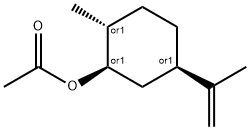Phenethyl acetate
Synonym(s):2-Phenethyl acetate;2-Phenylethyl acetate
- CAS NO.:103-45-7
- Empirical Formula: C10H12O2
- Molecular Weight: 164.2
- MDL number: MFCD00008720
- EINECS: 203-113-5
- SAFETY DATA SHEET (SDS)
- Update Date: 2025-01-27 09:38:02

What is Phenethyl acetate?
Chemical properties
CLEAR COLORLESS TO PALE YELLOW LIQUID
Chemical properties
Phenethyl acetate occurs in a number of essential oils and is a volatile aroma component of many fruits and alcoholic beverages. Phenylethyl acetate is a colorless liquid with a fine rose scent and a secondary, sweet, honey note. It is used in perfumery as a modifier of phenylethyl alcohol, for example, in rose and lilac compositions. In addition, it is used in a large number of aromas, in keeping with its natural occurrence.
Chemical properties
Phenethyl acetate has a floral odor reminiscent of rose with a honey-like undertone and a sweet, fruit-like taste reminiscent of raspberry.
Occurrence
Reported found in apple, banana, currants, guava, grapes, pineapple, tomato, strawberry, melon, cinnamon, cassia leaf, clove bud, peppermint oil, vinegar, breads, cheeses, butter, beer, cognac, whiskies, cider, sherry, grape vines, tea, Arctic bramble, olive, passion fruit, plum, mushroom, starfruit, Bantu beer, mango, fermented radish, litchi, wort, Bourbon vanilla, brandy, naranjilla fruit, lamb’s lettuce and eucalyptus oil.
The Uses of Phenethyl acetate
2-Phenethyl acetate is a highly valued natural volatile ester with a rose-like odour and is widely used to add scent or flavour to cosmetics, soaps, foods and drinks.
The Uses of Phenethyl acetate
Phenylethyl acetate mantains the typical rose notes of Phenylethanol with a more intense honey profile which is perfect for fruit and alcoholic drink applications. It is used as a pharmaceutical intermediate and also it holds application in gas chromatography and liquid chromatography.
Definition
ChEBI: The acetate ester of 2-phenylethanol.
Preparation
By acetylation of phenylethyl alcohol.
Aroma threshold values
Detection: 3 to 5 ppm
Taste threshold values
Taste characteristics at 50 ppm: fruity, sweet, honey, floral, tropical, rosy with a slight yeasty, honey note with a cocoa and balsamic nuance.
Synthesis Reference(s)
Journal of the American Chemical Society, 96, p. 8113, 1974 DOI: 10.1021/ja00833a047
Tetrahedron Letters, 31, p. 2273, 1990 DOI: 10.1016/0040-4039(90)80204-Y
General Description
Phenethyl acetate is a volatile flavor compound reported to be found in Malaysian cocoa beans, cheddar cheese, wine, brandy, and other grape-derived alcoholic beverages.
Flammability and Explosibility
Non flammable
Biochem/physiol Actions
Taste at 50 ppm
Safety Profile
Moderately toxic by ingestion. Mddly toxic by skin contact. A skin irritant. Combustible when exposed to heat or flame; can react vigorously with oxidizing materials. To fight fire, use alcohol foam, CO2, and dry chemical. When heated to decomposition it emits acrid smoke and irritating fumes. See also ESTERS
Properties of Phenethyl acetate
| Melting point: | -31 °C |
| Boiling point: | 238-239 °C (lit.) |
| Density | 1.032 g/mL at 25 °C (lit.) |
| vapor density | 5.67 (vs air) |
| vapor pressure | 8.7Pa at 20℃ |
| FEMA | 2857 | PHENETHYL ACETATE |
| refractive index | n |
| Flash point: | 215 °F |
| storage temp. | Sealed in dry,Room Temperature |
| form | neat |
| color | Colorless to Almost colorless |
| Odor | at 100.00 %. floral rose sweet honey fruity tropical |
| Water Solubility | NEGLIGIBLE |
| JECFA Number | 989 |
| BRN | 638179 |
| Dielectric constant | 4.5(14℃) |
| CAS DataBase Reference | 103-45-7(CAS DataBase Reference) |
| NIST Chemistry Reference | Acetic acid, 2-phenylethyl ester(103-45-7) |
| EPA Substance Registry System | 2-Phenylethyl acetate (103-45-7) |
Safety information for Phenethyl acetate
Computed Descriptors for Phenethyl acetate
| InChIKey | MDHYEMXUFSJLGV-UHFFFAOYSA-N |
Phenethyl acetate manufacturer
New Products
Methyl (R)-1-Boc-4,4-difluoropyrrolidine-2-carboxylate 2,2-Difluoropropylamine hydrochloride tert-butyl 3-bromoazetidine-1-carboxylate (R)-1-Boc-3-hydroxypyrrolidine DIFLUOROACETIC ANHYDRIDE 2,2-Difluoropropionic acid Diallylamine, 99% Calcium hydroxide, 95% Aluminum oxide, basic 2-Bromophenylacetonitrile, 97% L-tert-Leucine,97% N-Hydroxy-2-methylpropanimidamide 4-(3,4-Dichlorophenyl)-3,4-Dihydro-N-Methyl-1-(2H)-Naphthalenimine (Schiff Base) 2-AMINO-3,5-DIBROMO BENZALDEHYDE [ADBA] L-Glutamic Acid Dimethyl Ester Hcl 10-Methoxy-5H-dibenz[b,f]azepine 5-Cyanophthalide N, N-Carbonyldiimidazole (CDI) Dibenzoyl Peroxide Titanium Dioxide 2-(Methylthio) Benzonitrile Sodium Acetate Anhydrous Allopurinol 1,5-DibromopentaneRelated products of tetrahydrofuran








You may like
-
 103-45-7 2-Phenylethyl acetate 99%View Details
103-45-7 2-Phenylethyl acetate 99%View Details
103-45-7 -
 2-Phenylethyl acetate 103-45-7 98%View Details
2-Phenylethyl acetate 103-45-7 98%View Details
103-45-7 -
 103-45-7 98%View Details
103-45-7 98%View Details
103-45-7 -
 Phenylethyl acetate, 99% CAS 103-45-7View Details
Phenylethyl acetate, 99% CAS 103-45-7View Details
103-45-7 -
 2-Phenylethyl Acetate CAS 103-45-7View Details
2-Phenylethyl Acetate CAS 103-45-7View Details
103-45-7 -
 103-45-7 98%View Details
103-45-7 98%View Details
103-45-7 -
 2-Phenethyl acetate CAS 103-45-7View Details
2-Phenethyl acetate CAS 103-45-7View Details
103-45-7 -
 Phenethyl acetate CAS 103-45-7View Details
Phenethyl acetate CAS 103-45-7View Details
103-45-7
